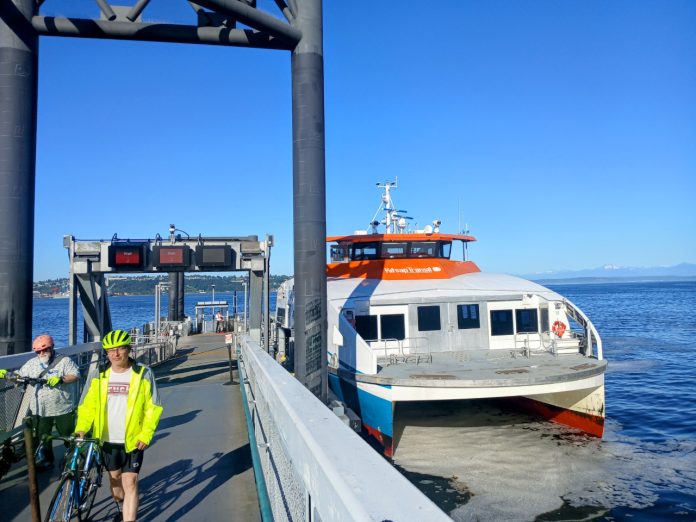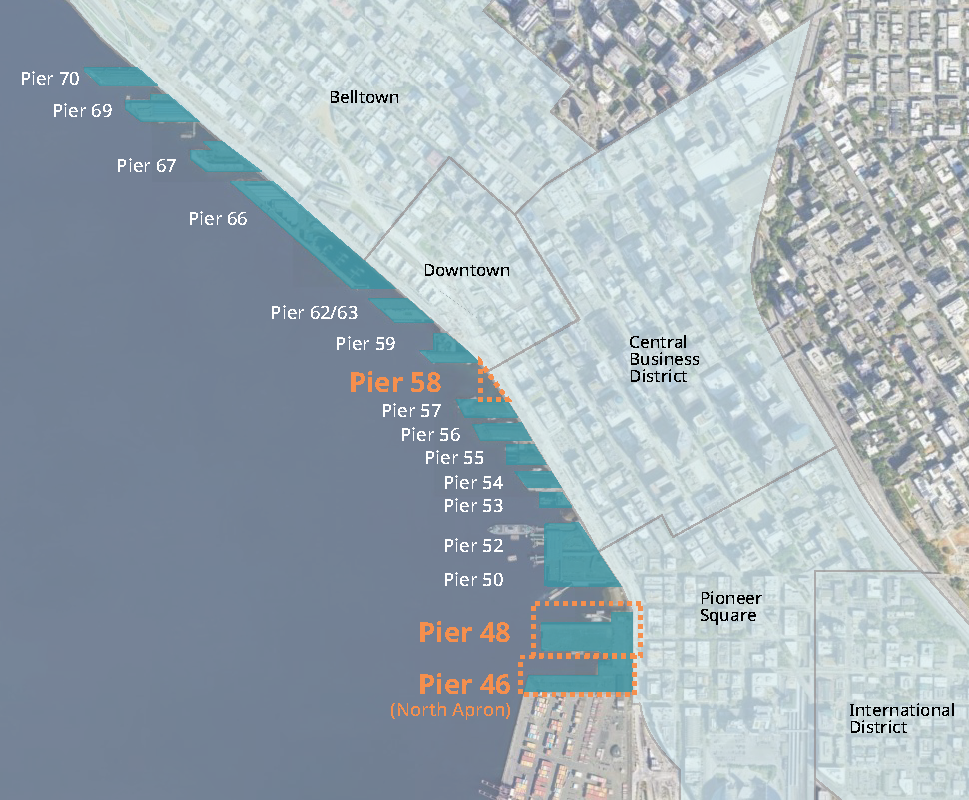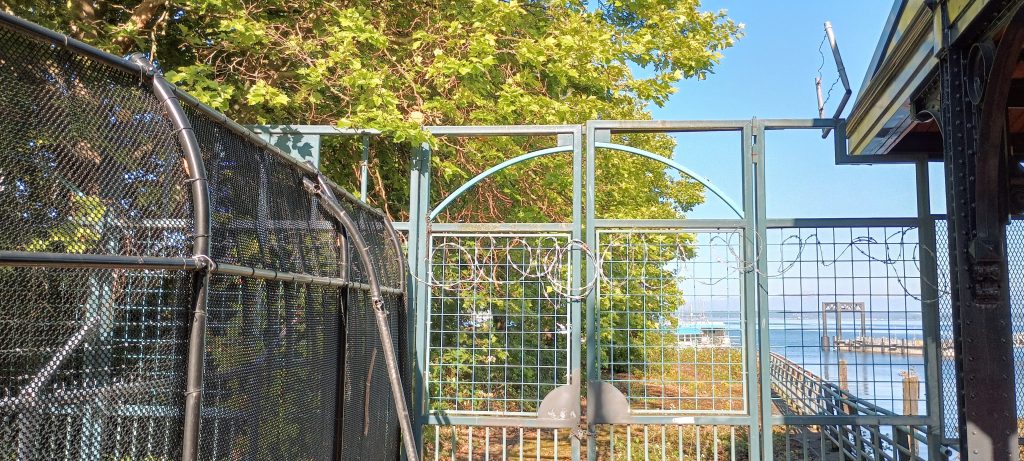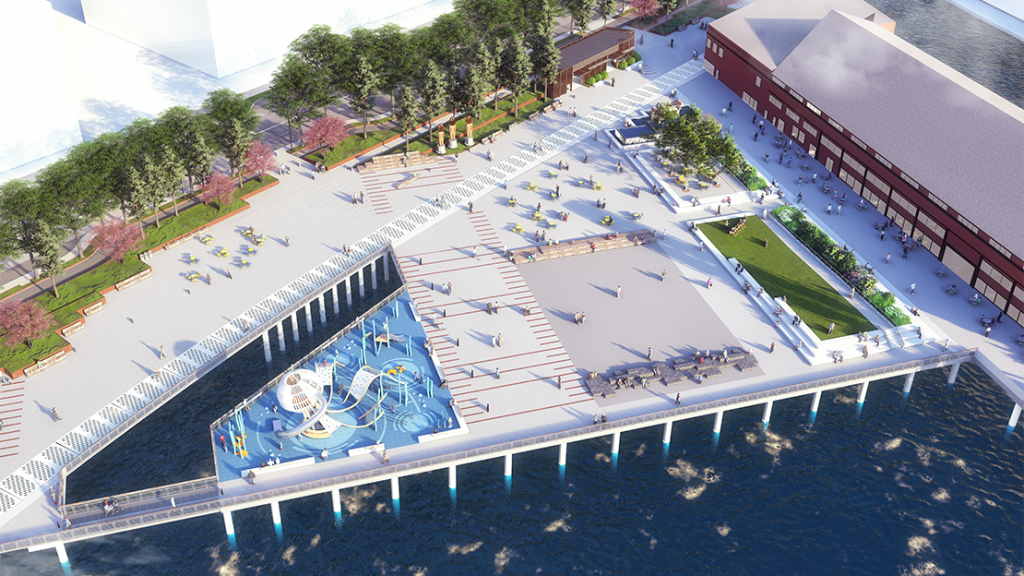
Kitsap Transit is officially considering three potential sites for a brand new fast ferry terminal on the Seattle waterfront, an essential ingredient in any future expansion of passenger ferry service across Puget Sound. The existing terminal Kitsap Transit uses, King County’s Pier 50, can only accommodate two vessels loading or unloading at a time, which creates operational issues when any boats are delayed and caps the number of trips that can be scheduled at peak times.
The agency’s preferred option is state-owned Pier 48 right next door, where King County holds a short-term lease on a maintenance float. But two additional options are set to be carried into a full environmental analysis: a portion of Pier 46 to the south, and newly rebuilt Pier 58 further north. Kitsap Transit is accepting comments to guide the scope of that environmental analysis through August 11, with the goal of completing its review by 2027.

Without a larger terminal, Kitsap Transit can’t expand service during peak hours beyond 12 landings, limiting the potential of adding additional routes. Along with providing space for additional vessels, a new Seattle terminal is intended to improve rider amenities (Pier 50 doesn’t have its own restrooms) and expand access to electric vessel charging.
Kitsap Transit has been eyeing potential sites for a terminal for several years. The project’s full environmental review comes at a time of uncertainty for fast ferry service into Seattle, with the state legislature pivoting away from what had looked like a potential new golden age for passenger-only ferries. The state transportation budget approved this spring prioritizes the Washington State Ferries (WSF) network ahead of passenger ferries, which lawmakers viewed as a supplement during times of reduced WSF service.
The legislature also declined to advance a bill making it easier for local governments to set up fast ferry districts, though that proposal may return in a future year.
The restoration of pre-pandemic service levels on WSF, including the return of two-boat service to Bremerton and three-boat service to Vashon Island, appears to have increased the perception that supplemental passenger ferry service is less essential, despite the ability for fast ferries to reduce travel times for riders, provide additional connectivity, and reduce climate pollution. Kitsap Transit’s foot ferries are twice as fast as WSF’s larger car-laden ferries.
Last month, King County announced the extension of supplemental service between Vashon Island and Downtown Seattle through 2027, but Kitsap Transit appears likely to reduce service levels on its Bremerton route as supplemental state funding runs out. King County and Kitsap Transit are in negotiations over a $4 million allocation that will determine the near-term future of those service levels. Potentially on the chopping block is the entirety of Saturday service to Bremerton through the off-season, which many riders have come to rely on.
“Kitsap Transit will continue operating state-funded supplemental Bremerton Fast Ferry service beyond Monday, June 30,” an announcement in late June noted. “Kitsap Transit is taking this step to avoid unnecessary disruption to riders while it continues to work with Washington State Ferries (WSF) to determine the level of state funding available for extending these additional sailings. Kitsap Transit will notify the public at least 30 days before the last day of the supplemental sailings.”

Pier 46, the preferred site for a new fast ferry terminal, is owned by the Washington State Department of Transportation (WSDOT), and mostly sits unused and deteriorating. The state has earmarked $20 million to start demolishing the existing pier, work that would have to proceed any future use for the property, but that demolition work hasn’t started yet.
A decade ago, as part of the Waterfront Seattle project, the City of Seattle considered what a redeveloped Pier 48 could look like as additional park space that also included space for passenger ferry berths. Funded by the state’s Department of Commerce, that design work has been sitting on a shelf, and it’s not clear what exactly the City of Seattle’s vision for the space looks like right now. Recently the site has come back on the City’s radar as part of Bruce Harrell’s Downtown Activation Plan, but details on that work have been scarce.

In selecting potential sites, Pier 48 rose above the rest in its potential to accommodate Kitsap Transit’s growing fleet. “[Kitsap Transit] selected the Pier 48 property as the proposed preferred alternative because it ranks high on all five criteria and is the only one that has sufficient space to support a long-term [passenger-only ferry] terminal facility without affecting other waterfront properties,” a 2023 screening report noted.

The other two sites Kitsap Transit is looking at are longshots.
“A new terminal located at the Pier 46 North Apron is feasible but would require demolition of the existing Pier 48 and long-term use of in-water space on the Pier 48 property,” that report continued. Pier 46 is also being eyed for base expansion by the U.S. Coast Guard, a move that the Port of Seattle has pushed back on, arguing that base expansion would give up valuable cargo loading space.
Even less likely is Pier 58, which has not yet reopened as a park space as part of the Waterfront Seattle project, though work is nearly done. The newly rebuilt pier includes a new children’s playground, a refurbished fountain area with seating, and an artificial lawn. Adding berths for ferries is possible, but making way for amenities for riders would likely mean pushing out park uses. “The Pier 58 location is also feasible with respect to available space but would require coordination with the City of Seattle (City) for potential modifications of the City’s plans for their new park,” the scoping document noted.

Despite the near-term uncertainty around passenger ferry service levels, the Seattle Waterfront will continue to be a high-demand space when it comes to ferry service, and Kitsap Transit completing the full environmental would be a big step forward for future expansion.
The Kitsap Transit Board of Directors is set to hold a public hearing for the official scoping period on July 15, at 8:30am.
Ryan Packer has been writing for The Urbanist since 2015, and currently reports full-time as Contributing Editor. Their beats are transportation, land use, public space, traffic safety, and obscure community meetings. Packer has also reported for other regional outlets including BikePortland, Seattle Met, and PubliCola. They live in the Capitol Hill neighborhood of Seattle.

